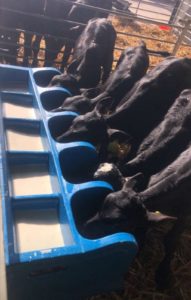Lower ambient temperatures during the Winter months increase calf energy requirements as they use more energy to maintain body temperature.Calves less than three weeks of age are the most vulnerable to changes in temperature, so when it gets cold outside, it is vital to have a strategy in place to help support calf performance.
It is well known young calves have limited energy reserves and lipid stores in newborn calves are extremely low; sufficient for a maximum of 15 hours of survival without feed. (Okamoto et al.,1986).
If milk or milk replacer supply, and therefore total nutrient intake, is not increased to compensate for lower temperatures, both growth rate and energy available for the immune system will be compromised.
The best practice is to limit maximum concentration to 150g of milk replacer made up to 1 litre with water, as this will manage the overall osmolality levels in the mixed milk replacer.

Osmolality measures the concentration of particles in a solution and is calculated by adding the concentrations of sugars and minerals. Calf milk replacers with elevated levels of osmolality can damage gut integrity, increase the risk of abomasal bloat or exacerbate diarrhoea severity in sick calves.
Before the ambient temperature starts to drop it is worthwhile double-checking feeding practices, for example, check the weight of the grams of milk replacer in a jug or recalibrate the automatic calf feeder, this will support the correct feeding curves.
If volume intake is limited due to the feeding system, increase concentrations carefully. Increase feeding rates by no more than 100g over 6-8 litres/day, whilst keeping an eye on calf performance. An alternative option, depending on labour availability, is to consider increasing feed frequency by moving from two to three feeds a day being mindful of time between feeds.
Calf jackets can be used to help keep calves warm and dry when temperatures fall below 15°C. Maintaining the hygiene of jackets is important, making sure they are washed between calves is critically important to calf health as it reduces the risk of any cross contamination.
Ensuring the jackets are high quality and breathable ensure calf comfort. Calves must be dry before adding a jacket, wet hair cannot insulate the calf.
A trial run by Harper Adams University found that using coats on calves born between December and February added more than 5kg to calves’ overall weight gain to 12 weeks.
Alongside calf jackets, increasing available bedding material for nesting and eliminating draughts is a useful strategy. Do not mistake drafts for ventilation. Good ventilation and adequate stocking density rates are key to successful winter housing conditions.
For more information or advice on winter feeding management, speak to your local NWF Sales Specialist, call 0800 756 2787 or get in touch with our technical team HERE.
